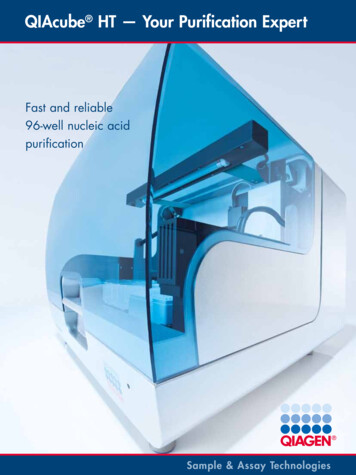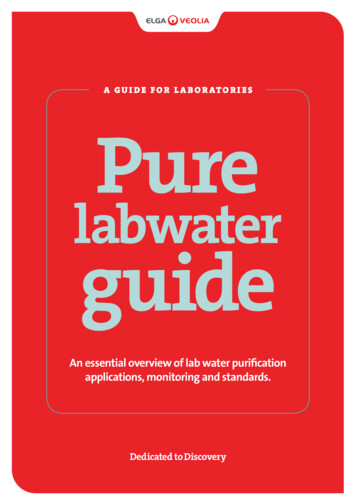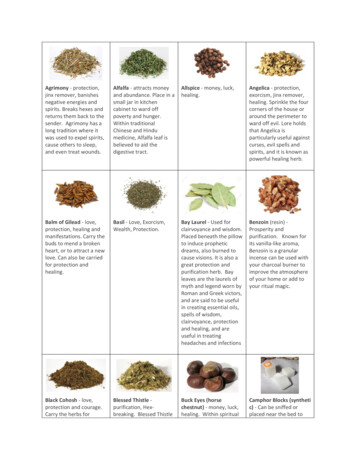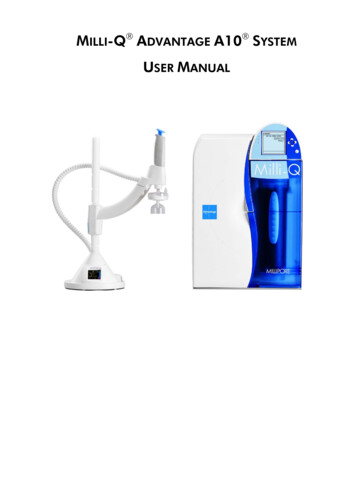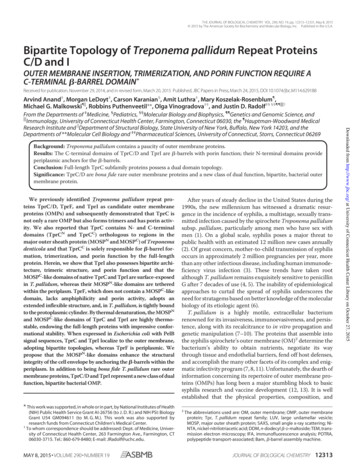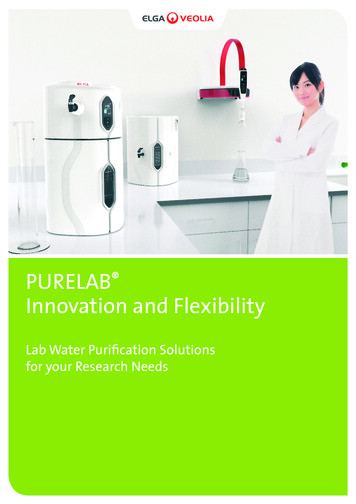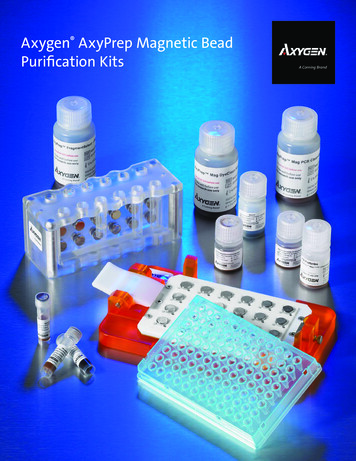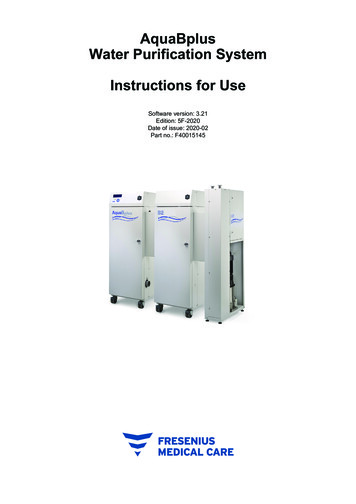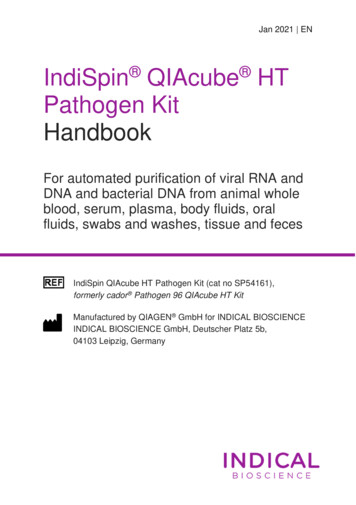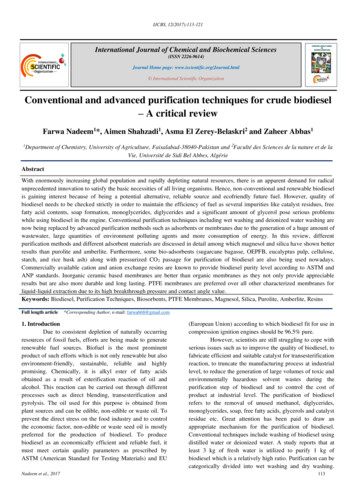
Transcription
IJCBS, 12(2017):113-121International Journal of Chemical and Biochemical Sciences(ISSN 2226-9614)Journal Home page: www.iscientific.org/Journal.html International Scientific OrganizationConventional and advanced purification techniques for crude biodiesel– A critical reviewFarwa Nadeem1*, Aimen Shahzadi1, Asma El Zerey-Belaskri2 and Zaheer Abbas11Department of Chemistry, University of Agriculture, Faisalabad-38040-Pakistan and 2Faculté des Sciences de la nature et de laVie, Université de Sidi Bel Abbes, AlgérieAbstractWith enormously increasing global population and rapidly depleting natural resources, there is an apparent demand for radicalunprecedented innovation to satisfy the basic necessities of all living organisms. Hence, non-conventional and renewable biodieselis gaining interest because of being a potential alternative, reliable source and ecofriendly future fuel. However, quality ofbiodiesel needs to be checked strictly in order to maintain the efficiency of fuel as several impurities like catalyst residues, freefatty acid contents, soap formation, monoglycerides, diglycerides and a significant amount of glycerol pose serious problemswhile using biodiesel in the engine. Conventional purification techniques including wet washing and deionized water washing arenow being replaced by advanced purification methods such as adsorbents or membranes due to the generation of a huge amount ofwastewater, large quantities of environment polluting agents and more consumption of energy. In this review, differentpurification methods and different adsorbent materials are discussed in detail among which magnesol and silica have shown betterresults than purolite and amberlite. Furthermore, some bio-adsorbents (sugarcane bagasse, OEPFB, eucalyptus pulp, cellulose,starch, and rice husk ash) along with pressurized CO 2 passage for purification of biodiesel are also being used nowadays.Commercially available cation and anion exchange resins are known to provide biodiesel purity level according to ASTM andANP standards. Inorganic ceramic based membranes are better than organic membranes as they not only provide appreciableresults but are also more durable and long lasting. PTFE membranes are preferred over all other characterized membranes forliquid-liquid extraction due to its high breakthrough pressure and contact angle value.Keywords: Biodiesel, Purification Techniques, Biosorbents, PTFE Membranes, Magnesol, Silica, Purolite, Amberlite, ResinsFull length article*Corresponding Author, e-mail: farwa668@gmail.com1. IntroductionDue to consistent depletion of naturally occurringresources of fossil fuels, efforts are being made to generaterenewable fuel sources. Biofuel is the most prominentproduct of such efforts which is not only renewable but alsoenvironment-friendly, sustainable, reliable and highlypromising. Chemically, it is alkyl ester of fatty acidsobtained as a result of esterification reaction of oil andalcohol. This reaction can be carried out through differentprocesses such as direct blending, transesterification andpyrolysis. The oil used for this purpose is obtained fromplant sources and can be edible, non-edible or waste oil. Toprevent the direct stress on the food industry and to controlthe economic factor, non-edible or waste seed oil is mostlypreferred for the production of biodiesel. To producebiodiesel as an economically efficient and reliable fuel, itmust meet certain quality parameters as prescribed byASTM (American Standard for Testing Materials) and EUNadeem et al., 2017(European Union) according to which biodiesel fit for use incompression ignition engines should be 96.5% pure.However, scientists are still struggling to cope withserious issues such as to improve the quality of biodiesel, tofabricate efficient and suitable catalyst for transesterificationreaction, to truncate the manufacturing process at industriallevel, to reduce the generation of large volumes of toxic andenvironmentally hazardous solvent wastes during thepurification step of biodiesel and to control the cost ofproduct at industrial level. The purification of biodieselrefers to the removal of unused methanol, diglycerides,monoglycerides, soap, free fatty acids, glycerols and catalystresidue etc. Great attention has been paid to draw anappropriate mechanism for the purification of biodiesel.Conventional techniques include washing of biodiesel usingdistilled water or deionized water. A study reports that atleast 3 kg of fresh water is utilized to purify 1 kg ofbiodiesel which is a relatively high ratio. Purification can becategorically divided into wet washing and dry washing.113
IJCBS, 12(2017):113-121Different solvents which may be organic or inorganic inmembrane is to ensure pressure driven separationnature are used in wet washing.methodologies that can be via reverse osmosis,Considerably large volumes of most of theultrafiltration and microfiltration. Initially, all thecommonly used solvents such as petroleum ether, n-hexane,membranes used were cellulosic in nature nevertheless nowcyclopentylmethyl ether (CPME), 2-methyltetrahydrofurana-days, polycarbonate, polysulphone, polyamide and various(2-meTHF) etc. are produced during purification ofother advanced polymers are also being extensively used.biodiesel even if the solvents are reused. Furthermore, theseThese artificially prepared polymeric membranes has shownsolvents are toxic in nature and are not environmentbetter resistance and improved chemical stability towardsfriendly. To solve this problem, green solvents have alsomicrobial degradation. In addition to this, some recentbeen introduced but these are not cheap enough to be usedresearchers remarked that PAN is asymmetric and porousfreely at an industrial scale. Dry washing involves the use ofmembrane that possesses high rate of permeation along withdifferent adsorbents which possess both acidic and basichigh selectivity. However, in the organic solvents, theseadsorbing sites for the attachment of impurities. Althoughpolymeric membranes can swell thereby instantly or longadsorbents are more efficient for purification, their usageterm changing the pore size. Consequently, such types ofstill requires dealing with solid waste at the end of thepolymeric membranes in number of solvent applicationsprocess. Commonly used adsorbents are magnesol,have significantly shortened the operating lifetimes.bentonite, magnesium silicate, aluminium silicate, silica gel,Nonetheless, much attention has been paid on different typesactivated carbon and activated clay etc. Recently, some bioof inorganic membranes owing to be superior then organicadsorbents have been used as sugarcane bagasse and oil freemembranes in maintaining the thermal, mechanical andpalm fruit bunch. These have shown considerably goodchemical stability, high flux, high porosity, resistance toresults and are also environment friendly. Another methodmicrobial degradation, long lifetime, increased resistance tofor the purification of biodiesel includes the use of oilfouling and relatively a narrower pore size distribution.freepressurized passage of CO2 from crude biodiesel.Thus, these porous inorganic membranes (like Al 2O3, TiO2,Purification membrane is the most advancedZrO2 and SiC) possess some extra practical advantages overmethod for purification of biodiesel that can be eitherpolymeric ones such as higher mechanical strength andorganic or inorganic in nature. The basic purpose to use thisthermal and corrosive resistance among others.Table 1 Impurities in biodiesel, their origin and technique for removal of impuritiesImpuritiesOriginRemoval MethodMethanolIt is the excess alcohol left unreacted at theWater washing and evaporationend of transesterificationGlycerolThe by-product that is still present in traceWater washing and adsorptionamountSoapProduced through saponification of freeNeutralization, distillation andfatty acidswater washingDiglycerides andProduced in transesterificationSeparate membrane andMonoglyceridesadsorptionCatalyst ResidueMostly heterogenous catalyst residues inWater washing, separatetrace amountsmembrane and adsorption2. Wet Washing Process of Biodiesel PurificationBiodiesel has been most commonly purified by wetwashing for which organic solvents, mineral acids ordeionized water was used. Although wet washing results inhigh quality, purified biodiesel that meets the valuesspecified by ASTMD6751 and EN14214 standards, but thegeneration of large volumes of environmentally hazardouswastewater, rise in cost and energy consumption, loweringof biodiesel yield and longer required production timequestions its candidature for future usage [1]. Crudebiodiesel contains impurities like unreacted alcohol, glycerolresidue, catalyst residue and soap, out of which glycerol andalcohol are highly soluble in water and hence can easily beremoved by extensive water washing. If a sodium basedcatalyst was used then it can also be removed simply byNadeem et al., 2017water washing. Excess alcohol can also be distilled orevaporated before washing step. The presence of moisture ina free fatty acid containing feedstock, duringtransesterification, leads to soap formation which not onlyconsumes catalyst but also results in an extra unwanted layerof soap that needs to be removed to prevent the formation ofan emulsion during washing. The moisture content ofbiodiesel is controlled either by drying over anhydroussodium sulphate or molecular sieves followed by filtrationor by stripping with a hot gas. Water washing has manyadvantages, but also it creates a number of problems, asevident in many research articles [2].2.1 Washing with Deionized WaterHot deionized water usually at 50-60oC is used forpurification of crude biodiesel for the separation of glycerol114
IJCBS, 12(2017):113-121phase. Methanol, glycerol and catalyst residue can becompletely eliminated from the final product. By now, theinfluence of water washing on the density, viscosity andacidity of the product has been studied by Gonzalo et al. [3].A single water washing step with constant stirring in thereaction vessel for 30 minutes was reported for the crudebiodiesel obtained from rapeseed oil or used cooking oilthrough acid catalyzed transesterification. The water contentin the product increased with increasing the washingtemperature and decreasing the amount of washing water.Coêlho et al. [4] reported the purification of biodieselproduced from castor oil by washing it at differenttemperatures (30 C and 70 C) and pH values (2 and 5).Acidified water was used to make emulsion containing 25%of crude biodiesel in the first wash. The amount of acidifiedwater was decreased in the following washes. The emulsionwas stirred and left to stand until the separation of thesephases. The final purified product was obtained aftercentrifugation when the biodiesel attained a neutral pHvalue [4]. The most influential factor on the amount ofwashing water was pH, followed by interactions of thecatalyst with pH and temperature. The amount of waterincreased with increasing the pH of the washing water from2 to 5. The effects of temperature and catalyst type werefound not to be statistically significant.2.2 Washing with Green SolventsFewer green solvents have been reported for thepurification of biodiesel which were organic and non-polarin nature. A purity level higher than recommended byASTM and EU (96.5%) were obtained by using these yclopentyl methyl ether (CPME). A comparison withhexane solvent was also made which showed almost similarresults. The usage of green solvents can provide an ecofriendly solution to avoid the use of toxic andenvironmentally hazardous acidic solvents. The productshowed higher viscosities and densities as compared to othersolvents but still fell in range prescribed by the ASTM andEU standards. However, the cost factor controls itsimplementation at the industrial level. At the laboratorylevel, liquid-liquid extraction and column chromatographytechniques were used for the purification of algae biodieselwith green solvents. In liquid-liquid extraction, an extrawashing step was needed in which the material was left fordecantation for 24 h [5].3. Dry WashingDry washing removes contaminants from crudebiodiesel by adsorption or passing crude biodiesel through abed of ion-exchange resin. Most operating procedures fordry washing are developed by trial and error. Differentadsorbent materials fulfil for treating crude biodiesel, suchas magnesium silicate (magnesol), calcium magnesiumsilicate and cheap biosorbents. The spent adsorbent can bedisposed of to landfill or other uses might be invented. Also,different types of ion-exchange resins are applied forNadeem et al., 2017waterless refining of crude biodiesel. Usually, small styrenebeads coated with polar functional groups are employed.The suppliers of these ion-exchange resins do notrecommend regeneration of the spent material. Therefore,the main drawback of dry washing is to find a solution forthe generated solid waste. Although the method usingmagnesol has a better effect on the removal of methanolthan ion-exchange resins, the purified biodiesels from bothprocesses might not fulfil the specifications of ENStandards. Dry washing refers to the removal ofcontaminants from biodiesel by using a bed of ion-exchangeresin or adsorbent. It is a waterless purification method thatinvolves treatment of crude product on the basis of trial anderror. The adsorbent materials being used commonly for thispurpose are magnesol (magnesium silicate), calciummagnesium silicate, amberlite, purolite; bentonite, hydratedmagnesium silicate, silica gel, activated carbon andactivated fibre and chamotte clay are also used as adsorbents[6].3.1 Dry Washing by Using AdsorbentAdsorbents are solid substances comprising ofbasic and acidic adsorption sites that attract oppositelycharged incoming substances e.g. glycerol and methanol etc.In dry washing using adsorbents, diglycerides, triglyceridesand free glycerols can easily be removed up to reasonablelevels with zero wastewater generation and in comparativelylesser washing time. The procedure can easily beincorporated in the existing plant as it requires lower spaceand minimizes total surface area coverage of the wash tank.Dry washing using adsorbent materials is also reported bysome scientists to be cost effective and efficient in terms ofproduction time. Another benefit is that water content ofpure biodiesel as specified by ASTMD6751 i.e. below 500ppm is possible to achieve as no water is utilized in thewashing of crude biodiesel. While in water washing, theaddition of water removal step in the process makes it morecomplicated, costly and time consuming as water usuallyexceeds 1000 ppm concentration which is not acceptable.A study reported commercial silica gel and ricehull ash for the removal of free fatty acid contents of thecrude biodiesel under atmospheric conditions and the resultsshowed silica gel to be a better adsorbent providing smallerloss of methyl esters. The content of methyl esters in thefinal product increased with increasing the silica gel dosage.Commercially synthesized silica gel has been used forpurification of biodiesel obtained from different feedstocksusing methanol and alkali catalyst. At first, methanol wasremoved from the crude biodiesel by vacuum evaporation.Then, the biodiesel was stirred with silica gel for 20 minutesand filtered to remove the silica gel. Finally, the filtrate waspassed through a bed of sodium sulfate to remove traces ofwater. The canola methyl ester had physical and chemicalproperties similar to diesel fuels. The acid value of the finalproducts was below the specified limit. The115
IJCBS, 12(2017):113-121physicochemical properties of the purified biodiesel wereaccording to ASTM standards.Yori and coworkers used freshly prepared silica inthe form of fixed silica beds for removing glycerol frompurified biodiesel and glycerol mixtures which showed abetter glycerol removal i.e. up to 0.13 gg-1. Different factorssuch as feed rate, the concentration of glycerol and mass ofadsorbent affected the breakthrough point of silica bed. Dueto the coinciding saturation point and breakthrough point,maximum adsorption was attained when the particle sizewas 1-1.5 mm. With greater silica beads (1/8in), thebreakthrough point was at about one-half of the time for fullsaturation because of internal mass transfer limitations.Treatment of used silica bed with methanol (4 bed volumes)followed by drying in a nitrogen stream for 1h canregenerate the adsorbent for reuse. The ability of adsorbentfor glycerol removal is not affected by the presence of soapor small amounts of water. However, the saturation capacitydecreases with increasing mono-acyl-glycerol and methanollevels in the crude biodiesel.The activated bleaching earth is another adsorbentreported in the literature which was employed to palm oilderived biodiesel. The final reaction mixture of alkalinecatalyzed ethanolysis of palm oil containing pure glycerolwas heated for 1 minute at 70W in the microwave oven andthen separated by gravity. The resulting layers were heatedat 80 C for methanol removal. The adsorbent is then mixedand centrifuged where optimum concentrations of glyceroland adsorbent were 10% and 1.2% respectively. Theresulting product purity lied within the specified range ofASTM standards. Same adsorbent material was also used forthe purification of biodiesel obtained from Pollock oilthrough alkali catalyzed transesterification. The biodiesel toearth mass ratio of 1:10 was used. The results proved theactivated bleaching earth to be an effective adsorbent forbiodiesel purification.Some scientists used a natural adsorbent preparedfrom clay material (i.e. natural silica-smectite mixture) forbiodiesel obtained from soybean oil. Both free and totalglycerol contents were reduced to appreciable levels incomparison with commercially manufactured syntheticmagnesium silicate adsorbent. Some recent investigatorsshowed that activated low silica bentonite (120–200mesh)was an efficient adsorbent for purifying biodiesel. Thenatural material was activated with 0.1M sulfuric acid at100 C for 1h. Freundlich model was used to study theadsorption of impurities on the adsorbent. Activated silicabentonite provided 47% of glycerol removal when 5% of itwas used.A recent study reported the comparison of differentadsorbents i.e. magnesol , silica, amberlite BD10 DRY and purolite PD 206 for their efficiency in the treatment ofbiodiesel obtained from soybean oil for impurities removal.The comparison was based on the amount of impurity likemethanol, soap, residual water or potassium removed by thatNadeem et al., 2017particular adsorbent. As a result, we observe that magnesol and silica showed better adsorption properties than amberliteBD10 DRY and purolite PD 206 , especially for removingsoap, free and bonded glycerol and potassium. The mainresults found for these two adsorbents (magnesol 1% andsilica 2%) were values below 0.17 mg KOH g-1 for acidnumber, 1 mg kg-1of potassium, 61 ppm of soap, 500 mg kg 1of water, 0.22% of methanol and 0.03% of free glycerol [78].3.1.1 Chamotte Clay AdsorbentChamotte clay is a solid waste of red ceramicindustry which was utilized as inorganic dry wash adsorbentfor the removal of glycerol from crude biodiesel. Itsstructure and composition were studied by X-ray diffraction,FTIR and SEM to determine its capability to be used asadsorbent. Chamotte levels of 2.5 w/v% at 45 C maximizedglycerol removal (1282 mg glycerol g 1) with minimum lossof adsorbate. Biodiesel from palm kernel oil was used as asample. After treatment with chamotte clay, significantlylower glycerol content ( 0.02 wt%) were found incomparison with crude biodiesel (0.29 0.03 wt%).Monoacylglycerols and diacylglycerols were also reportedto be removed by the adsorbent [9].Table 2 Potential adsorbents and their usesAdsorbentsDescriptionReferencesChamotte ClaySolid Waste from[9]Red CeramicIndustry andGlycerol RemovalMagnesolMetals, Alcohols,[10]Diglycerides,Glycerol and SoapSilica GelAlcohol, Water,[10]Soap and PotassiumHydrated[11]MagnesiumSilicateActivated 3.1.2 Activated CarbonActivated carbon is another method of treatment forthe purification of crude methyl esters. Activated carbonobtained from spent tea waste was compared with syntheticadsorbent silica gel and conventional water washingprocesses. The results proved the activated carbon to bebetter than the other two. Biodiesel not only resulted inhigher yield but also showed better fuel properties.Moreover, the used activated carbon can be regenerated andreused. In another investigation, biodiesel was refined viaactivated carbon, activated clay, activated fibers and acidclay. It was reported that the grain size effects thepurification of biodiesel as clay grain size that ranged116
IJCBS, 12(2017):113-121between 0.1 mm and 1.5 mm gave better yield. The smallergrain size of clay particles helps to achieve betterpurification. However, the removal of spent adsorbentproves more cumbersome. When the size of clay grain islarger, the purification process is inferior but separation afterthe treatment becomes simple. Usually, activated carbonsare mostly employed as an adsorbent for the removal ofexcess color in biodiesel [10].4. Bio-Adsorbents Used for PurificationA number of adsorbent materials that are currentlybeing used for purification of crude methyl esters areoriginated from plants that are organic in nature. These areusually extracted from plant materials and are either in theform of ashes, raw material, extracted cellulose or starch orfibrous material. These adsorbents usually have higheradsorption capacity, larger surface area and are evensometimes porous in structure.4.1 Sugarcane Bagasse Bio-AdsorbentDry washing of crude biodiesel using bioadsorbents is a new trend as these are inexpensive,biodegradable, non-toxic and easily available. However,research is being done to ensure biodiesel quality andprocess efficiency while using bio-adsorbents. Sugarcanebagasse has been proposed as a cheap adsorbent which wasapplied in its three different forms i.e. raw sugarcanebagasse (as received), steam explosion pre-treated bagasseand bagasse ash. An efficient glycerine removal wasreported by adding only 0.5 wt% of sugarcane bagasse togain 0.02 wt% of total glycerine content in purifiedbiodiesel with 88.86 mgg-1 glycerine adsorption. Kineticstudies showed it to be a fast process where more than 70%of glycerol was removed in 10 minutes of the adsorptionprocess. Sugarcane bagasse presented results for biodieselpurification similar to those for wet washing process or withmagnesol . Thus, dry purification with sugarcane bagasseis a suitable alternative for biodiesel treatment at a low costand efficient process [12].4.2 OPEFB Bio-AdsorbentA naturally extracted bio-adsorbent was fabricatedby pressing and shredding oil palm empty fruit bunch andused to remove impurities from crude biodiesel obtainedafter transesterification of waste cooking oil. The operatingprocedure involved the implication of 5 different wt%concentrations of bio-adsorbent under continuous stirring at500 rpm for 1 h. For 5 wt% loading concentration of bioadsorbent, 89.7% of residual methanol, 81.7% of water,36.7% of free fatty acid and 98.6% of potassium removalwas obtained which met European standards for biodiesel(EN14214). In comparison to commercial adsorbents andthe water washing method, purification using oil palmempty fruit bunch derived bio-adsorbent resulted in higherremoval of free fatty acids, potassium, water impurities anda smaller loss of fatty acid methyl esters. The bio-adsorbentis not only renewable but also provides the ease ofNadeem et al., 2017operations and considerably efficient results for thetreatment of crude biodiesel.4.3 Coco Coir as Bio-AdsorbentCoco coir is a heterogeneous natural fibreconsisting of coco pith, coco fibre and coco chips, collectedfrom coconut husks. Chemically, it is cellulosic fibrousmaterial whose sponge like pith is known to participate inion exchange reactions. It is studied in research as a readilyavailable, cheap, durable, renewable and biodegradable drywash adsorbent material that can be effective for theremoval of contaminants from biodiesel. The ability of cococoir bio-adsorbent to separate soap, methanol and freeglycerol from crude biodiesel was examined along with itslong term stability and efficiency. The results proved thatcoco coir bio-adsorbent is not only stable enough to last fora time period greater than 5 years but also provides biodieselqualities as required i.e. it lowers soap concentrations up to3000 ppm in a single column pass, removes free glycerol,free fatty acids and methanol up to satisfactory levels evenwhen large volumes of raw biodiesel are treated at industrialscale. Moreover, it did not show any increase in Ca2 orMg2 in the treated product [13].4.4 Starch and Cellulose as Bio-AdsorbentsNatural adsorbents are usually non-toxic,biocompatible, renewable and easily degradable in naturewhich generate minimal waste at the end of the process.Cellulose and starch have been reported for their use in thepurification of fatty acid methyl esters obtained fromsunflower oil. Cellulose and starch used for this purposewere extracted from potato starch, corn starch, rice starch,cassava starch and eucalyptus bleached kraft cellulose. Anindustrial adsorbent select 450 was also employed in thestudy in order to make a comparison. Differentconcentrations of selected adsorbents were chosen 1%, 2%,5% and 10% (w/v) at 25 C for 10 min. For the evaluation ofthe efficiency of the adsorbent chosen, different parameterssuch as acidity index, combined alkalinity, free glycerineand turbidity of biodiesel were determined. All the selectedadsorbents showed considerably good results regarding thepurification of biodiesel which proved the future usage ofnatural adsorbents promising enough to be employed at anindustrial scale [14].4.5 Eucalyptus Pulp as Bio-AdsorbentsBiodiesel produced from sunflower oil andrecycled cooking oil was treated with different techniques tostudy their efficiency in metal removal (mainly Fe, Mn andCu) from crude biodiesel. Biodiesel treated with cellulosicadsorbent resulted in the removal of 13–81%, 35–84% and40–74% of Fe, Mn and Cu while when washed withdeionized water, it removed 4–40%, 10–47% and 4–19% ofFe, Mn and Cu. So and cellulosic are not only much moreefficient but are also eco-friendly, non-toxic, renewable andbiocompatible in nature. Moreover, the adsorbent can beregenerated. On the other hand, waste deionized watercontaining metal ions have to be treated before its disposal.117
IJCBS, 12(2017):113-121This study also provided results for the removal of Fe, Mn,Cu and Pb from fatty acid methyl esters obtained fromsunflower oil and residual cooking oil using kraft pulpeucalyptus fibres. The cellulosic fibres have great potentialfor adsorption of metals as these possess active hydroxylgroups that can attach metal ions. The efficiency ofregenerated cellulose was also discussed as it gave 62%,84% and 70% removal of Fe, Mn and Cu from biodiesel[15].4.6 Rice Husk AshA comparison of rice husk ash, commerciallyavailable magnesol (1% w/w) and conventionally used acidsolution (1% aqueous H3PO4) was made for the purificationof biodiesel obtained through transesterification of wastefrying oil. Rice husk ash is a by-product of rice processingand was used as bio-adsorbent for the removal of glycerolfrom the crude biodiesel. Different concentrations i.e. 1%,2%, 3%, 4% and 5% w/w were used in the process. The 4%concentration provided the best results as compared to otherconcentrations. This result was because of the presence ofhigh silica content as well as the structure which comprisedof meso and macropores in the rice husk ash. Hence, ricehusk ash appears to be effective bio-adsorbent for thetreatment of crude biodiesel [10].Table 3 Impurities removed by some effective bioadsorbentsBioDescriptionImpurities dustrialMethanol,Waste, PressedWater andand ShreddedPotassiumOil PalmEmpty FruitBunchCoco CoirHeterogeneousSoap,[13]Natural FiberMethanolCollected fromand FreeCoconut HusksGlycerolEucalyptusCellulosicMetals like[15]PulpAdsorbentFe, Mn andcontainingCuKraft PulpEucalyptusFibreCelluloseObtained fromMetal,[14]and StarchNaturalTurbidity,Sources likeGlycerineRice, Corn,andPotato andAlcoholCassavaSugarcaneUsed asFree[12]BagasseBagasse AshGlycerineRice HuskObtained fromGlycerol[15]Nadeem et al., 2017AshAgro-IndustrialWaste andNaturalCellulosicAdsorbent5. Dry Washing by Using Ion Exchange ResinsAnion and cation exchange resins have been usedfor biodiesel purification for many years. These may be usedas a bed of adsorbent or in form of column. Ion exchangeresins are also used for the catalysis of oil for the synthesisof biodiesel. However, much work is needed to be done tofabricate simultaneous transesterification and purification toobtain a cleaner biodiesel product from feedstock oil [17].SP112H and GF101 were reported to treat crude biodieselfor its free fatty acid component as well as mono-acylglycerol, di-acyl-glycerol and tri-acyl-glycerol, water andglycerol. Results were satisfactory for their use in furtherstudies [18]. The cation exchange resin, "diaion PK208LH",and the anion-exchange resin, "diaion PA306S" werereported by [19]. The methanol content which was 1.0 wt.%in the effluent was reduced to 0.2 wt.% by evaporationunder pressure. Most of the impurities like free fatty acidcontent, soap, glycerol, total water content and mono and diglyceride contents fell into the specific range as prescribedby (EN14214) and the USA (ASTM D6751).6. Membrane TechnologyMembranes are selectively permeable barriers thatcan separate the constituents of a mixture by restricting orallowing its passage
techniques were used for the purification of algae biodiesel with green solvents. In liquid-liquid extraction, an extra washing step was needed in which the material was left for decantation for 24 h [5]. 3. Dry Washing. Dry washing removes contaminants from crude biodiesel by adsorption or passing crude biodiesel through a
